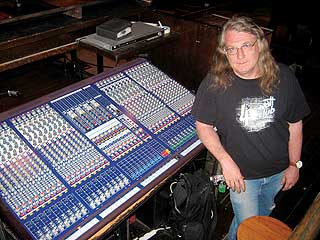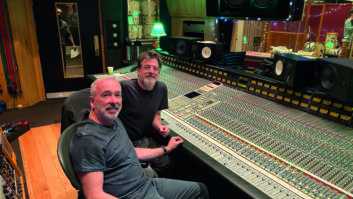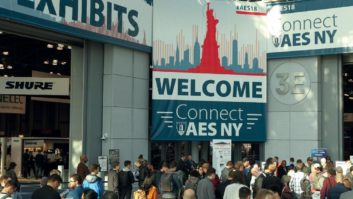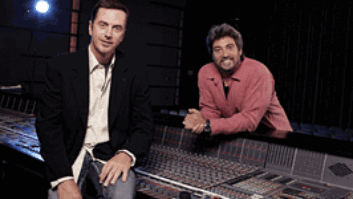
Noel Ford: “We always take a Korg KP2 KAOSS pad because [band Boris] has some very specific vocal effects that they use during the show.”
Photo: Brian L. Schwartz
Whether it’s because of the state of the economy in general or a struggling music industry in particular, more tours are carrying less gear. Reduced trucking and airline baggage expenses are just a few of the reasons why touring engineers are relying on house-provided equipment. Factor in the success and popularity of festival circuits for both the bands and the concertgoers, and it’s easy to see why this has become a rising trend in the concert industry.
What would you do if you were about to embark on this type of tour and could only carry one audio toy with you? What item would make your mixing duties easy if you had it, or difficult if you did not? Mix asked several live sound engineers for their answer to the “Desert Island Gear” question.
Essential Mics
Engineer Noel Ford, whose duties include mixing front of house for Dinosaur Jr., says that when he is out with that particular band, he is typically working in good venues and is “comfortable with the processing that the house has to offer. I do like to have certain mics though,” he says. “J Mascis [singer/guitarist] uses a lot of vintage gear, including Marshall and Hiwatt heads, and lots of old effect pedals. This can result in J getting shocks from his microphone, but with a Shure SM57 he won’t ever get a shock, so I always make sure to have a Shure SM57 for him [laughs]. We have tried wireless systems as well as some other solutions, but the SM57 has proven to be the workhorse. Sometimes the simplest things are exactly what you need.

Jacob Feinberg on the Sennheiser e 935: “I have a long-standing history with many of the artists I work with, and I’ve been able to introduce that mic to them early on so they are familiar with it.”
Photo: Brent Lind
“After a lot of experimentation,” he continues, “I have found that I can get a nice warm sound from J’s guitar rig using a combination of Sennheiser e906s and e609s. I have tried many vocal microphones for Lou [Barlow, bassist], but the Beyer M88 suits his voice and I get more clarity from that mic than any other. It works for Lou in his monitors, as well. I carry a Sennheiser e901 for inside kick — the e901 is awesome when you have a closed front head — and an Audix D6 for outside kick. I am a big fan of the D6 because I can get that little bit of top that helps it cut through the mix, as well as a solid low end. I’m just not happy if I don’t have a D6!”
Ford is also using the SM57 on hi-hat, saying that the band’s stage setup is very tight and he can get a lot of bleed from the bass amp into the hi-hat mic. “The bleed is less ferocious with the 57 than it would be with a condenser microphone. Using the same mics in different rooms provides a nice basic reference point.”
Over a period of more than 35 years, Bob “Nitebob” Czaykowski has worked with artists ranging from Aerosmith, KISS, Ted Nugent and Ace Frehley to Hanoi Rocks and most recently Madeleine Peyroux, New York Dolls and Steely Dan. Nitebob agrees that having the right mic for the lead vocalist is paramount: “I consider that to be the most important element of a live show,” says Czaykowski. “Be it a Neumann, Sennheiser, Shure or something else, I want a mic that has not been overused or damaged. I find more damaged vocal mics than anything else; kick drum mics come a close second. Madeleine prefers the [Neumann] KMS 104 because she feels it suits her voice, and it works for me. David Johansen [formerly of New York Dolls] uses the Beta 58 because it complements his voice and works well when he plays harmonica.”

Frank Marchand III carries a Phonic PAA3 to get a feel for what the room is doing and be able to make adjustments.
While Czaykowski is particular in his mic selections, he’s not as picky about certain pieces of outboard gear, noting that most modern digital desks have the comps, gates and effects he requires. “Though if I am in a situation where I can spec the tour, I’d like a mixing desk that suits the needs of the act — maybe a Digidesign with a Waves [plug-in] package or a well-maintained Midas, etc.”
Frank Marchand III, whose credits include Calexico and Bob Mould, says, “The thing that single-handedly has solved more problems for me than anything else has been showing up with my own microphones. I have a bag of 15 or 20 mics that I drag out, mics that I know that will generally work in all situations and aren’t horribly expensive, so if the bag gets stolen or something breaks, I am not heartbroken. Having a few SM58s that are in good shape that I know work all the time helps me evaluate the monitor response relative to what I expect from the sound of those microphones. I have been in some clubs where you look at the microphone and it has rust on the grille. Why would I put someone in a position that they need to have a tetanus shot just to go sing on that thing? If all of a sudden you lose a channel or something goes wrong with a line, you can eliminate one variable in the chain. Even if we are on a festival circuit, I’ll replace the vocal mics with mine because the artist will know that they are singing on the same mic every night — which brings consistency to the monitor mix.”
When I ask Jacob Feinberg (currently on tour mixing FOH with Monsters of Folk) about his “go-to” gear, he laughs and quips, “There are a lot of one things I’d like to have. If I could only carry one thing, it’d be the vocal mic, probably a Sennheiser e 935. I have a long-standing history with many of the artists I work with, and I’ve been able to introduce that mic to them early on so they are familiar with it. If they don’t like it, then I’ll use whatever they want, because ultimately they have to be comfortable onstage with the sound they are getting back. Having said that, most of the artists I work with have embraced the e 935 because the mic speaks for itself when I get it in front of them. It has a ton of gain and a lot of presence and articulation, which is important when you are working with a singer/songwriter. It’s also very tight in the low-mids so I don’t need much EQ.
“When I work with Gillian Welch,” he continues, “we have five microphone inputs. They have been using 58s and 57s for a decade now, and I’ve never recommended anything else. We carry the mics, they are comfortable with them and that’s their sound. It is a different scenario from other artists I mix. On this tour, Jim James from My Morning Jacket has gone through a lot of vocal mics. He is not someone I normally mix and he had been using other mics. I put up the e 935 and asked him to give it a shot. If everyone is consistent [i.e., if all the vocal mics are the same], I think it’s easier to dial in the monitors. He loved it and it has not been an issue since.”
Working With House Racks and Stacks
All of the engineers we spoke with agree that their choices of prime-time gear depend upon the type of tour. Feinberg says that if he has a “bit of luxury, if I am carrying a console — which I try to do as often as possible — I like to have a Dolby Lake Processor to drive the system and a tablet PC with a wireless router to run it. If I have that, I can walk the room and make adjustments. Even if I am using it only for the EQ and not crossover, I can go into any room and no matter what the P.A., I have the flexibility to turn anything I get into being usable. If the venue has a faulty crossover or a noisy house EQ, I can take it out of line and go straight into the Dolby Processor, adjust EQ and create crossover points if needed. If I am not carrying a console, having a DLP doesn’t make much sense because I can’t take advantage, and the consistency doesn’t matter as much. If I’m working on the house console, I’m pulling my mix out of nowhere anyway, so to a certain degree the [house] zero is equivalent to anything I might create. Most of the time, I’ll go from the Dolby Lake Processor right into the house crossover and I’ll run subs off an aux. If the house system is not set up to drive a sub from an aux [send from the console], I might have to create that crossover and that output, and go directly to their amps.”
Adam Robinson (whose recent tours include They Might Be Giants, Plain White T’s, Duncan Sheik and Mike Snow) concurs with Feinberg, adding, “I’ve used all of the Lake processors: the Dolby Lake, Lake Contour, Lake Mesa. If I’m on a tour and I don’t need all the I/O, the Lake Mesa is a great EQ unit. I’ve come across a lot of ailing systems, and having powerful EQ has always been helpful. On tours where I’ve had a 4×12 DLP, I’ve used it as a full system crossover in place of older or analog units [where venues have agreed to let us] and not just using the EQ functions.

Adam Robinson: “If I’m on a tour and I don’t need all the I/O, the Lake Mesa is a great EQ unit.”
Photo: Ben Laing
“At times, I’d go into places that have no idea what the processor truly is and they’d put up a bit of a challenge when I asked to hook it up to their system,” Robinson continues. “A bit of talking usually convinced them and then I’d show them why with my show. For instance, Duncan Sheik’s tour melded his pop catalog with his successful Broadway catalog. It wasn’t your typical rock show where you just put up a band and go. I had nine musicians onstage including a mini-orchestra. Having some powerful EQ was necessary not only to tame less-than-stellar systems, but also to keep feedback in check.
“I even would run a loop from the stage to FOH and EQ Duncan’s wedge mix [run by house-provided engineers] from the Lake. The combination of the Neumann [KMS 104] vocal mic — along with him liking wedges that can really get loud when he does — gave us a very unique challenge. Ninety-nine percent of the systems we came across have traditional 31-band graphic EQs. I find that more often than not, EQ problems do not exist exactly on 1/3-octave divisions. Additionally, when needing to make a single cut that might be an octave wide, the Lake — like any parametric EQ — makes only one cut, where your run-of-the-mill graphic requires cutting multiple frequencies, messing further with the phase response and rarely resulting in an even octave-wide curve. EQ’ing out feedback points on a standard graphic resulted in us just completely killing his mix. With the Lake, we were able to zero in on problem areas and not affect anything that wasn’t a problem in the first place.”
The Festival Circuit
Marchand has found that sometimes traveling with gear does not necessarily mean that one is able to use that gear: “When you’re on the festival or summertime circuit, you don’t have a lot of time for setup. Your priorities shift due to the time allotted and it becomes forensic audio: more about what you are correcting, not what you are connecting. It’d be nice to have a rack full of processing, but you need the time to be able to connect it.
“What I do travel with,” he continues, “is a Phonic PAA3 handheld analyzer. The PAA3’s mic is attached so it gives me the ability to take it into the crowd. I’ll put it into spectrum analysis mode and walk the venue. Most venues have weird room modes or comb filtering, and even 20 feet away from the mix position you might have no idea what people are hearing. I’ll look at the screen and see if there’s a bump or notch in the frequency response. I also use it as an SPL meter because I want to see what the bottom octave is doing. I want a big presence but I am not going to wipe out the crowd and walk away with my ears ringing. I am very conscious of watching the crowd during the show to see how people are reacting. That’s my indication that I am getting it right. I always mix a little different where I stand relative to the crowd because they have expectations of how the artist should sound and I try to hit that mark.”
Ford’s go-to gear “depends upon the band I am mixing. I also work for a Japanese heavy psych band called Boris. We always take a Korg KP2 KAOSS pad because they have some very specific vocal effects that they use during the show. We use the KAOSS for vocoder, reverse delay and the reverbs. The reverbs are gritty-sounding and are very cool. I use them on all of the singers at some point or another during the show. There’s also a nice dub echo preset that I’ll use on the drums on a couple of songs. I run an aux send out of the console into the KAOSS, return the KAOSS output to a channel and then dial it in. I have one and the band has one in Japan, so between us we always have a KAOSS pad. It really makes a huge difference in their sound and it’s fun to work with.”
Marchand adds one final comment of which all touring engineers are painfully aware: “After doing this for so long, the less I have to schlep to the airport, the less baggage I have to pay for, the less money flies out of my pocket! Oh, yeah, and I always bring Sharpies and marking tape!” Amen.
In addition to being Mix’s sound reinforcement editor, Steve “Woody” La Cerra is the tour manager and front-of-house engineer for Blue Öyster Cult.




